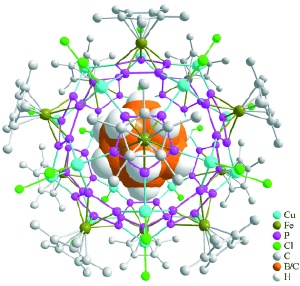Apr 30 2009
The discovery of a soccer-ball-shaped molecule made of 60 carbon atoms was a minor revolution in chemistry: Fullerenes are spherical, highly symmetrical molecules made of carbon atoms, and are the third form of carbon after diamond and graphite. However, the C60 "soccer ball" is not the only fullerene by far. Among its less stable relations is the C80 fullerene.
 © Wiley-VCH
© Wiley-VCH
There are seven different possible structural forms that have 80 carbon atoms in a symmetrical, spherical arrangement. Among the forms that are so instable they have not previously been produced is the icosahedral version (icosahedron= twenty-sided figure).
Instead, a team led by Manfred Scheer at the University of Regensburg has now synthesized the first example of an inorganic, carbon-free C80 analogue. As they report in the journal Angewandte Chemie, their fullerene-type system of building blocks can be produced by using a template (template-controlled aggregation).
The researchers used pentaphosphaferrocene (a five-membered ring made of phosphorus atoms bound to an iron atom) and copper chloride for their synthesis. Their template was a carborane—a compound made of carbon, boron, and hydrogen atoms—of the appropriate size (ca. 0.8 nm) and shape (pseudo five-fold symmetry). The individual building blocks aggregate around the carborane to form a spherical supermolecule with fullerene-type geometry, enclosing the carborane within the structure as a “guest molecule”. This gave the scientists a structure that corresponds to an icosahedral fullerene made of 80 carbon atoms. This scaffold is made of twenty copper and sixty phosphorus atoms that are arranged into twelve rings containing five phosphorus atoms each and 30 six-membered rings containing two copper and four phosphorus atoms. This inorganic shell interacts electronically with the enclosed guest molecule.
“Template-controlled aggregation has been shown to be an efficient route to large, entirely spherical molecules of fullerene-type topology,” says Scheer. “The guest molecule determines the size and composition of the fullerene-type product.”